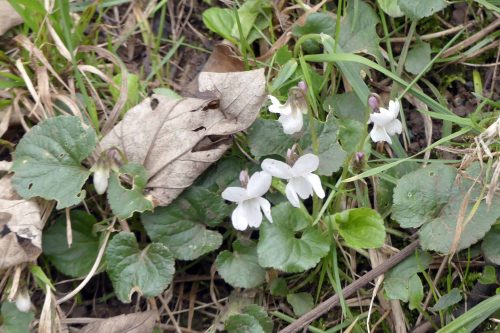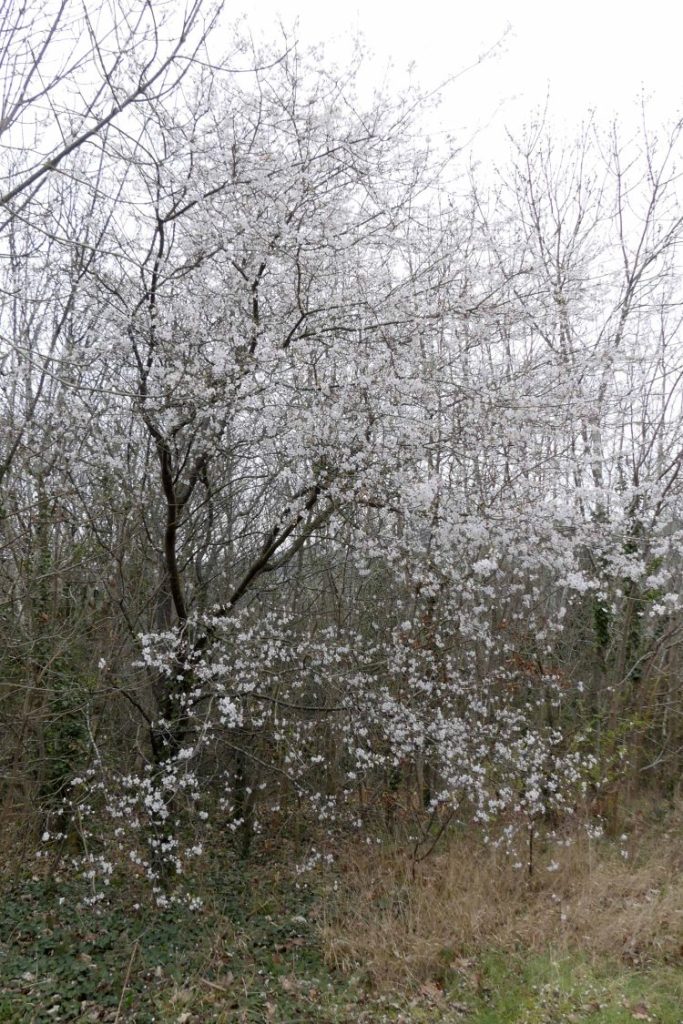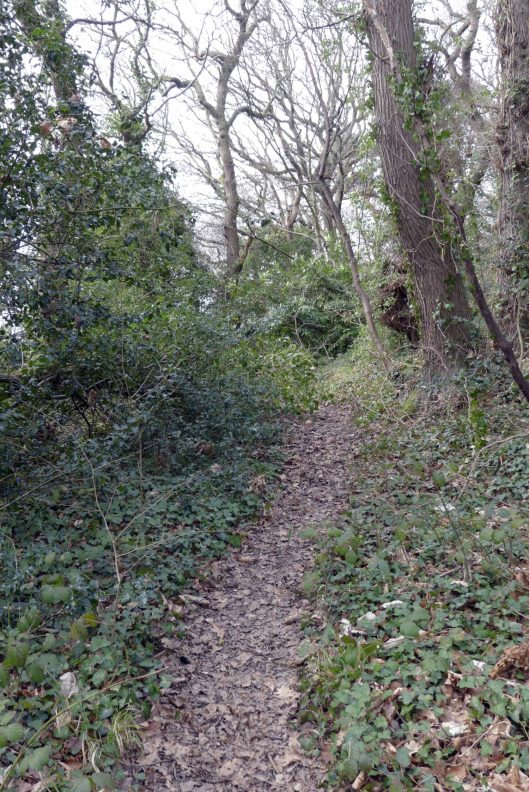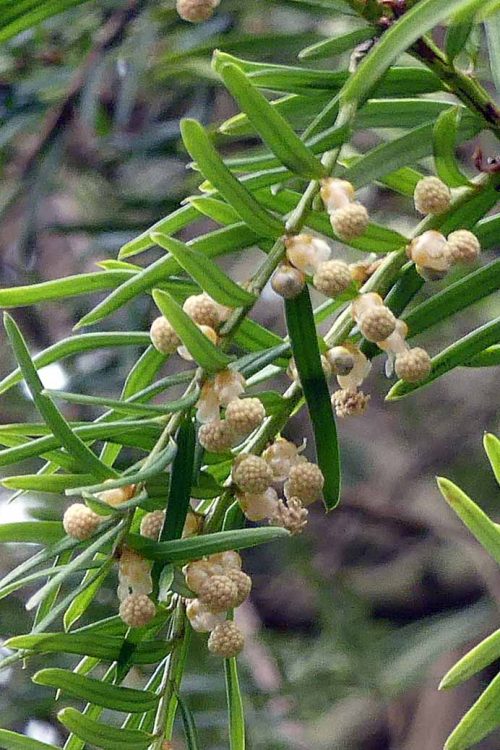Tags
Bryn Euryn Nature Reserve, cherry plum, early flowering trees, flowering in March, jelly-ear fungus, March, tree buds opening, woodland birds
Snow was forecast to reach us later in the day today and the prediction for the next few days sounded like stay-at home-and-catch-up weather. As there’s always the possibility they’d got it right, I had to take the opportunity to get outside while the going was still fairly good to scout for signs that spring is not too far away. The bright sunshine pouring through my windows had been deceptive. Outside it was very cold, bitterly so when the wind intermittently blew, and I headed for some shelter in the woods, I was soon glad of the extra layers I’d piled on.
There are two choices of path through the first part of the woodland; the ‘official’ signposted public path and one that is a little higher up, accessed by scrambling inelegantly up a rocky bank, which is the one I took today. This is my favourite path, less used and with more of a feel of ‘proper’, older woodland on either side. Even at this time of the year there’s usually something interesting to see; there are some lovely big old trees and there’s always the likelihood of catching sight of a bird or two along here too.
On either side of me I could hear the contact calls of blue tits and close by the scolding calls of a small bird, made whilst flitting animatedly from branch to branch of a small tree. The sun shining behind it meant I had to squint to see it properly, but as I suspected, it was a lovely little long-tailed tit. Fingers crossed it was one of a pair and they’re nesting somewhere close by.
Several trees have been lost from here over the last few years. Any loss is sad, but there’s some compensation in that the space they occupied and the extra light allowed through to reach the lower levels of the woodland, new plants have the opportunity to grow. There’s competition along the path edges, budding twigs of seedling ash cluster close together for now, but eventually some will thrive and others won’t. Other seeds fortuitously landed in more spacious spots and are growing quickly into sturdy saplings. Amongst them, no surprise, are several sycamores and a little less expected, a couple of horse chestnuts. These saplings have already begun to release their new leaves from their tight buds, needing to grab as much light as they can to help fuel their growth before the big trees open up theirs and close off the canopy. Both have the most beautiful buds that are just beginning to open.


As well as the sapling trees there’s a mixed scramble of shrubbery along the path edges, ground-covering ivy, long whippy canes of dog rose and thorny lengths of bramble snake out seeking spots in which to touch down and take root. Honeysuckle, always one of the first woodland plants to put forth new leaves clambers over whatever it comes into contact with and climbs upwards trees where it can. There’s an abundance of holly in plants of varying sizes; and checking one or two of the bigger shrubs I found one that already has flower buds. Closed tight at the moment, these are buds on a male plant and they will open up into tiny white, scented flowers. It will take there to be a female plant nearby to benefit from the pollen of the male flowers if there are to be berries. There are touches of mahonia, which despite managing to flower each year and increasing in number of plants, doesn’t seem to really thrive here; plants stay small with thin foliage and leggy woody stems. Although it’s an ‘incomer’ to the woods, its early flowers are a useful source of nectar and pollen for early foraging bumblebee queens.


The felled trunk of what I think was a sycamore tree caught my eye as it’s smothered with the fascinatingly formed jelly-ear fungus Auricularia auricula-judae. This fungus is also known by the common name Judas’s ear, translated from the Latin auricula – ear and judae – Judas. Unfortunately, at some point in the past this was mis-translated and was frequently also referred to as the now unacceptable Jew’s ear.
Strongly associated with elder trees, these old common names for the fungus came about in part because of their distinctive shape and because Judas Iscariat, the betrayer of Christ reputedly hanged himself from an elder tree. The accepted English name is now jelly-ear, which aptly describes both the shape and texture of the fungus and is unlikely to cause offence.
Towards the end of the path, the alexanders plants are flowering. A particular favourite of yellow dung flies, I’d already found a couple of them in this spot on an even earlier flower a week or two ago. Not today though -it was way too cold, even with their little furry coats.
Some spurge laurel plants still have flowers, others flowers and forming fruits and some just fruits.


In an open space a young hazel tree is gradually securing its place and is showing a good number of new fresh green leaves.


There are still catkins on the mature hazel trees. but they’re starting to look a bit straggly and worn now. These dangling tassels are the obvious showy, pollen-bearing flowers of the hazel and are male. You have to look much closer to find the female flowers, which when fertilised will develop into nuts; they are bright dark pink, but very tiny and remind me of miniature sea anemones.


A branch fallen from a tree has been left to lie across the path. It’s only slender, but it’s provided a barrier against trampling feet and cold winds and together with leaves trapped against it, it has provided a safe place for opportunistic plants. False brome (grass), lesser celandine, nettle and speedwell have all found a foothold here.
Out on the Woodland Trail, the flowering currant, another sometime garden escape has both its pretty pink blossom and new leaves.


Yew has separate male and female trees and they too are flowering now. On some trees the male pollen-bearing flowers are quite prolific and very visible. In close-up they look like miniature heads of cauliflower in close-up.
Female flowers are tiny and green and are much harder to see. I did look, but admittedly not too hard as it was too cold to stay still for long and I couldn’t find any today.

Further along the trail, the tall not-so-wild, cherry plum is still flowering beautifully, but not for much longer. Already many white petals are sprinkled like confetti on the earth of the trail beneath it, and it has already opened most of its new, red-purple tinted leaves.
On the muddy bank at the junction of the Woodland Trail with the ‘shortcut’ up to Adder’s Field the white sweet violets are out, although not doing too well this year. It’s not too surprising given the weather of the past year, but at least they’re clinging on. A purple flower amongst them caught my eye – there have only ever been white violets here that I have seen, but a closer look showed it to be an especially early, early dog violet.


This is often a good spot in which to see birds. There’s almost always a robin here, often the sight or if not, the song of a wren to be heard, blackbirds forage along the trail edges and in past years there have been mistle thrushes. Today a robin did appear for me, and there were glimpses of blackbirds rustled ivy leaves as they lunged for ripe berries. There were more sounds than sightings – a couple of disturbed wood pigeons clattered out of the trees, a great tit chimed his song, crows cawed and herring gulls squawked – a reminder that even though surrounded by woodland the sea is close by. Not a day for too much hanging about, I took the shortcut up to the field and came upon one of the treats of the day. A gorgeous jay was on the ground, rummaging in the deep leaf litter. It may have been searching for one of its autumn stashes of acorns, or perhaps was hoping to find insects. This is a hard time of the year for hungry birds.


Coming out from the shelter of the trees into the open field I was met by a cold wind and the first tentative flurry of fine snow. As I was about to move quickly on, another little bird caught my eye, a coal tit at the top of a branch of a small ash tree. This was my first sight of one so far this year and I’ve never seen one in this part of the reserve before, so another treat for the day.


The Cherry Plums
As I mentioned in my previous post, each year I look forward to seeing the ‘wild’ cherry plum tree here in its full glorious snowy-white blossom. Visiting it has become almost like an annual pilgrimage, a vision to behold at the end of winter that promises the approaching spring. I’d been a bit worried that I might have missed it at its best as I’d been away for a week or so, but having already seen the not-so-wild one earlier on, I was hopeful. It did not disappoint – despite there being a few petals sprinkled on the ground beneath, it was as beautiful as it could be, loaded to the tips if its branches with perfect starry white flowers.


The flowers of cherry plums almost always appear before the leaves and there are still only a few new glossy green leaves open yet; enough though to show the difference between this tree and the similar one on the other corner of this bottom end of the field. Quite young yet, this one is more of a tall shrub than a tree. It too has been flowering for a while, and has very similar-looking, although sparser pretty white blossom. It has already opened most of its leaves, which are quite well-grown. Tinted purple-red, the leaves show it has grown from the fruit of a cultivated variety of cherry plum, perhaps the similar big tree on the Woodland Trail that I passed earlier.


Walking up the hill to the top end of the field through thickening falling snow I picked up my pace and covered my camera, thinking I’d done for the day, but then the wind dropped and the snow stopped. As my dad would have said though, the sky was still full of it, so no doubt this would just be a brief lull.
Time though to have a look at the progress of the oak tree leaf buds – still tight as yet. At the end of one twig, what looks like a cluster of leaf buds is a knobbly growth produced by the knopper gall wasp, Andricus quercuscalicis, that causes ridged outgrowths, or ‘galls’, on the acorns of our native pedunculate oak. Forming in August they are sticky and red at first, then later become woody and brown. A second generation of the wasps then develops in the catkins of turkey oak.
Tucked into the shelter of blackthorn, a patch of budding celandines and leaves of lords and ladies, some marked with dark spots, others not.
Almost home – snowy white sweet violets carpet grass.
.. a pretty forget-me-not…
…. and a grey squirrel, watching me pass. Doesn’t it know they’re supposed to give us a break and stay tucked up indoors when it snows?














Hi Theresa, love your pics of sticky buds (nearly wrote sticky buns!). They always make me want to touch them and feel their stickiness. Fascinating photos of yew flowers, which I have never seen before. So something for me to look out for.
LikeLike